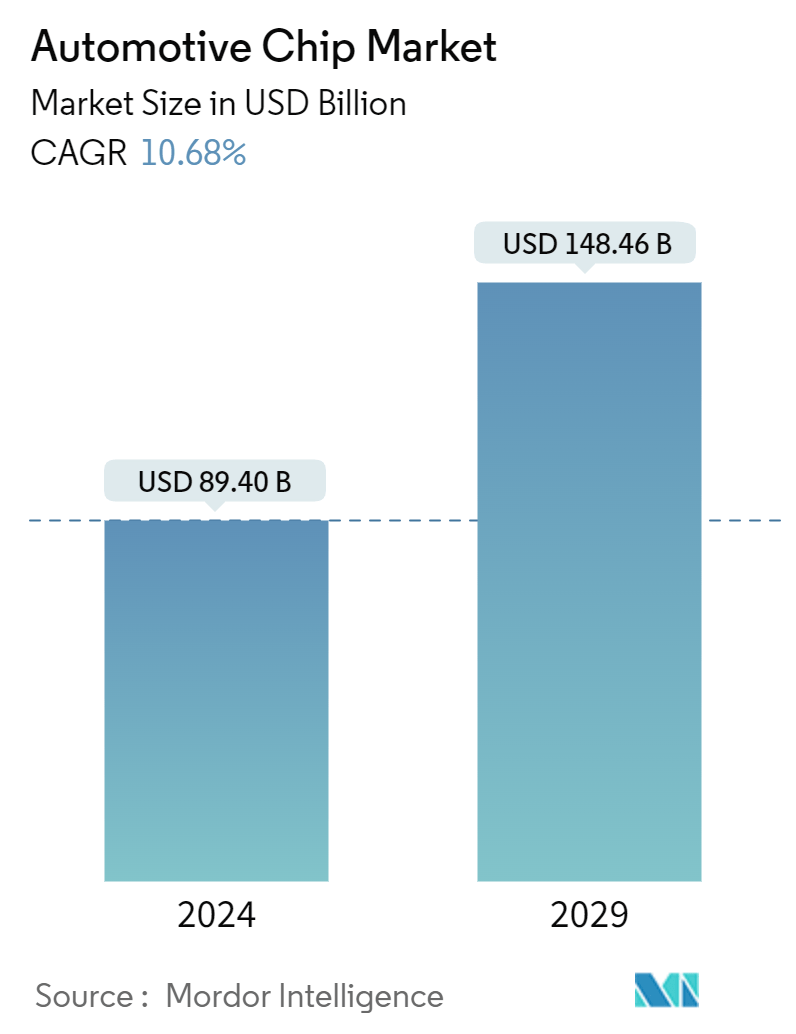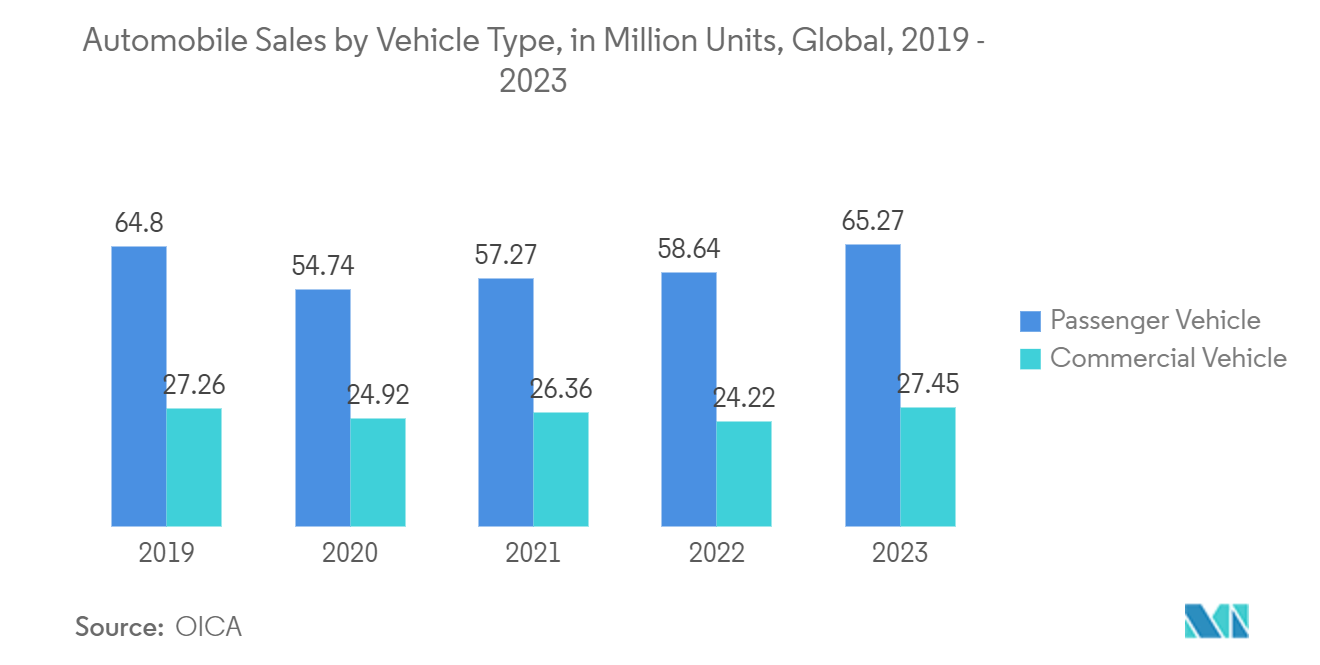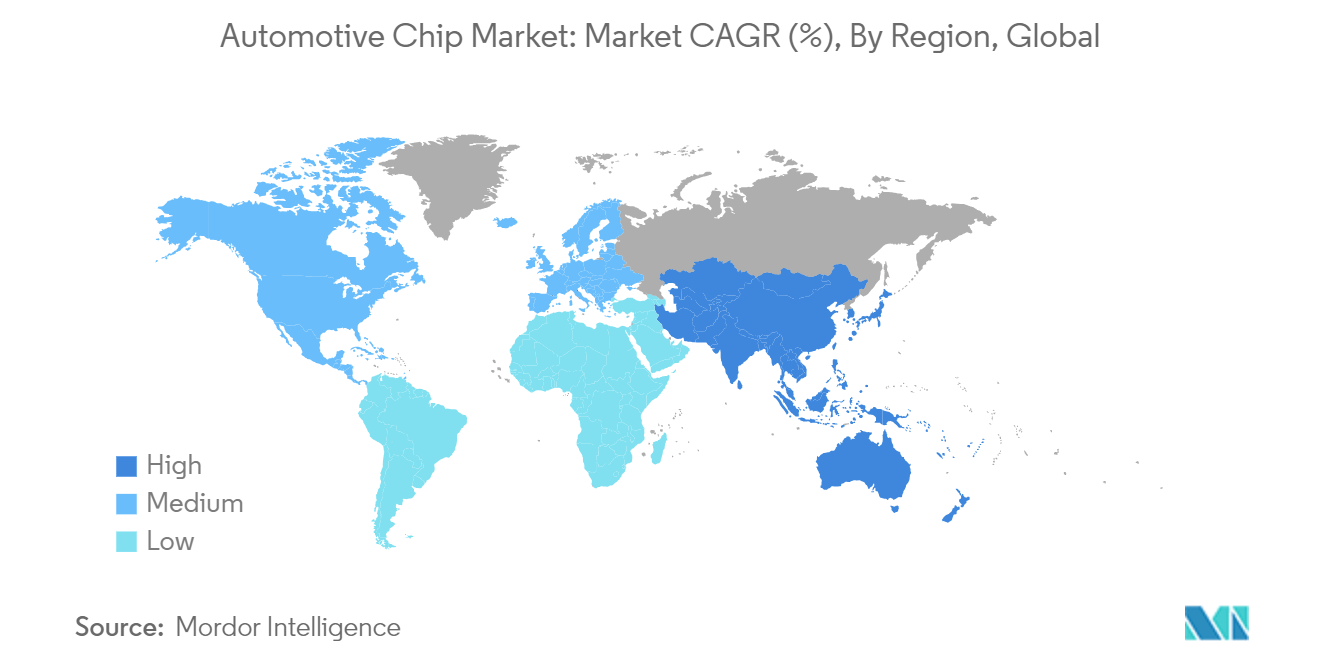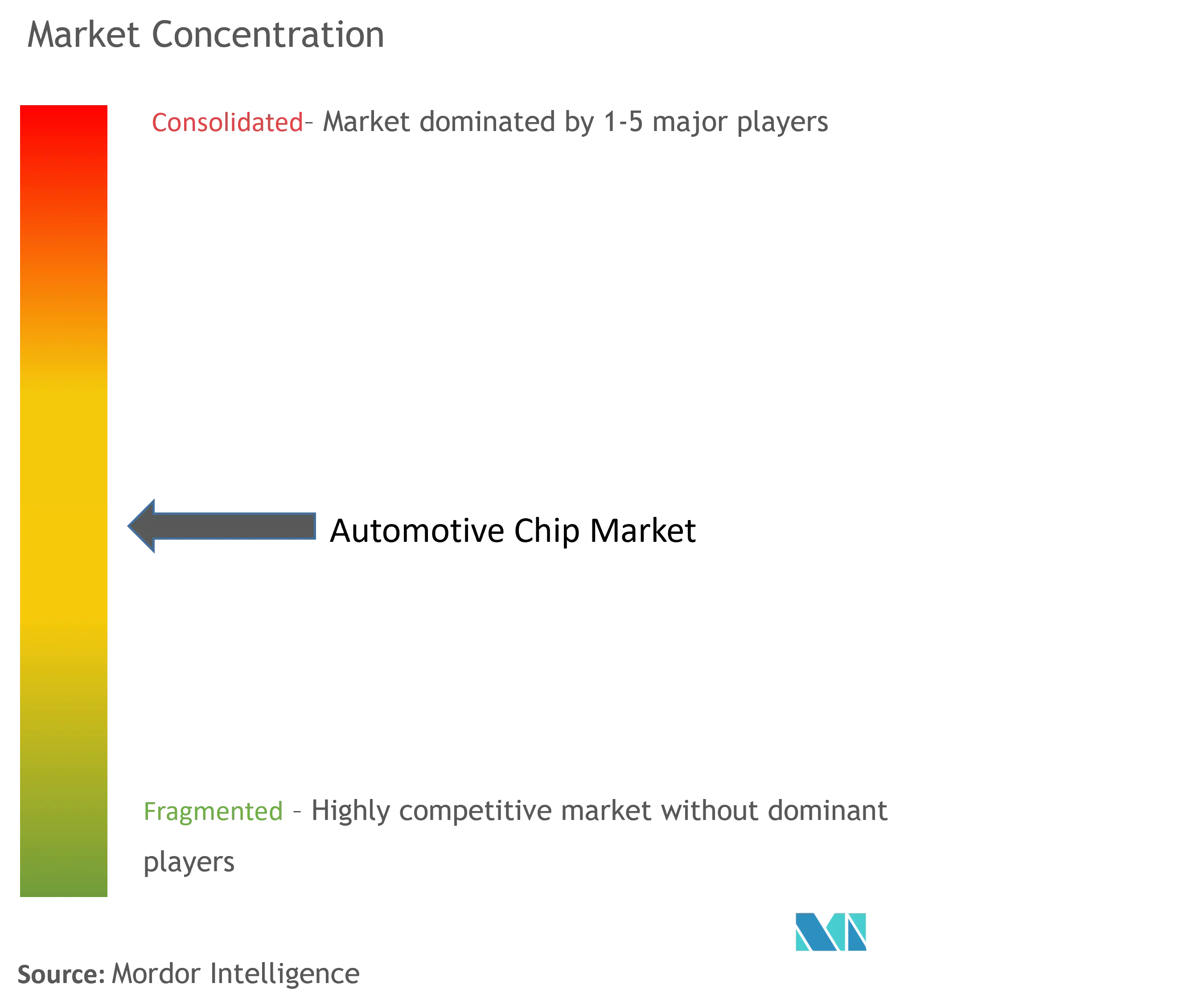Automotive Chip Market Size

| Study Period | 2019 - 2029 |
| Market Size (2024) | USD 89.40 Billion |
| Market Size (2029) | USD 148.46 Billion |
| CAGR (2024 - 2029) | 10.68 % |
| Fastest Growing Market | Asia Pacific |
| Largest Market | North America |
Major Players.webp)
*Disclaimer: Major Players sorted in no particular order |
Automotive Chip Market Analysis
The Automotive Chip Market size is estimated at USD 89.40 billion in 2024, and is expected to reach USD 148.46 billion by 2029, growing at a CAGR of 10.68% during the forecast period (2024-2029).
Demand for automotive chips is surging. This growth is fueled by the rising integration of electronic vehicle components, from luxury models to mass-produced cars. Key drivers include the widespread adoption of Electronic Control Units (ECUs), advanced infotainment systems, stringent fuel efficiency standards, and an intensified focus on vehicle safety.
- Governments worldwide, particularly in developed and emerging markets, have implemented stricter vehicle emission regulations to address environmental concerns and combat climate change. These regulations, such as the European Union's Euro emission standards and China's national emissions standards, are pushing automakers to develop and deploy more fuel-efficient and low-emission vehicles. One of the primary strategies to meet these emission regulations is the increased adoption of electric vehicles (EVs) and hybrid electric vehicles (HEVs).
- EVs and HEVs require significantly more semiconductor chips than traditional internal combustion engine (ICE) vehicles. The electrification of vehicles, including the powertrain, battery management systems, motor controllers, and advanced driver assistance systems (ADAS), necessitates the use of a wide range of semiconductor chips, such as microcontrollers, power management ICs, sensors, and communication processors.
- The automotive industry is swiftly progressing toward the goal of fully autonomous or self-driving cars. To realize this vision, autonomous driving technology demands substantial computing power, intricate algorithms, and a comprehensive network of sensors. These elements work in tandem to perceive the environment, make informed decisions, and adeptly control the vehicle. At the heart of this sophisticated technology lies a diverse array of specialized semiconductor chips, notably robust central processing units (CPUs), advanced graphics processing units (GPUs), and tailored application-specific integrated circuits (ASICs).
- However, with the rise of connected and automated vehicles, the threat of cyber attacks looms, raising serious concerns for safety and privacy. Automotive semiconductor chips, which oversee essential functions such as steering, braking, and engine management, have become prime targets for cybercriminals. Any chip design, software, or communication protocol vulnerabilities can allow hackers to seize unauthorized vehicle control, underscoring a significant security threat.
- The macroeconomic factors like chip shortage heavily impacted the industry as automakers lost billions, leading them to cut production volumes and remove popular features from their vehicles. Other factors, including personnel shortages and America's dependence on Asian suppliers, prompted further production cuts. Between 2021 and 2023, carmakers reduced production significantly, with manufacturing lead times ballooning to 10-12 months, up from the usual 3-4. While there have been recent boosts in production capacity, they fall short of meeting the heightened demand. Supply chain challenges continue to plague the industry, including manufacturing slowdowns, shipping delays, and material shortages.
Automotive Chip Market Trends
Passenger Vehicles Segment is Expected to Hold Significant Market Share
- Passenger vehicles are leading the charge in adopting advanced driver-assistance systems (ADAS) and autonomous driving technologies. Integral ADAS features such as lane-keeping assist, adaptive cruise control, and emergency braking rely on various semiconductor components, including sensors, microcontrollers, and AI/ML chips. With the growing sophistication of ADAS and the rising prominence of self-driving features, the semiconductor content in passenger cars is set to rise further.
- The growing adoption of electric and hybrid passenger vehicles is fueling a surge in semiconductor demand. These vehicles rely on various chips to oversee powertrains, batteries, charging systems, and electrical components. As automakers broaden their electric vehicle portfolios, the demand for automotive semiconductors in the passenger vehicle sector is set to escalate. For example, data from EAFO reveals that in 2023, all-electric vehicles constituted 15% of new passenger car registrations in the European Union.
- Consumer demand is peaking in the passenger car market for advanced infotainment systems, seamless connectivity, and timely over-the-air updates. These infotainment systems, digital cockpits, and connected car technologies depend on various semiconductor components. Notably, the semiconductor content for these features is typically more pronounced in passenger vehicles than in their commercial counterparts.
- The passenger vehicle market dwarfs the commercial sector in terms of volume. This disparity enables semiconductor suppliers to harness more significant economies of scale and achieve cost efficiencies when manufacturing chips tailored for passenger cars. Consequently, the heightened production volumes reduce per-unit costs, rendering chips for passenger vehicles more enticing. According to OICA, passenger car sales increased to 65.27 million units globally, compared to 27.45 million unit sales recorded for commercial vehicles.

Asia-Pacific Region is Expected to Grow Significantly
- Asia Pacific is poised to see a substantial surge in demand for automotive chips. Key players like China, Japan, South Korea, and India primarily drive this growth. These nations are home to some of the globe's leading automotive giants, including Toyota, Honda, Hyundai, Tata Motors, and Volkswagen's joint ventures in China. With these automakers setting up extensive production facilities and supply chains in the APAC region, a robust and consistent demand for automotive-grade semiconductor chips has emerged. Furthermore, the proximity of chip manufacturers to these automotive hubs in APAC not only streamlines supply chains but also curtails logistical expenses.
- China, in particular, is the world's largest and fastest-growing market for electric vehicles (EVs), driven by aggressive government policies and incentives. EVs require a much higher number of semiconductor chips per vehicle, ranging from 1,000 to 3,000 chips, compared to 200 to 300 chips in traditional internal combustion engine vehicles. The automotive chip market is significantly driven by the surging demand for chips in vehicles and the swift expansion of the EV market in the APAC region.
- Countries like Japan and South Korea are spearheading the development of cutting-edge automotive technologies in the APAC region. These technologies encompass autonomous driving, connected car features, and advanced driver assistance systems. Such innovations depend on specialized semiconductor chips, including microcontrollers, sensors, and communication processors. Given the APAC region's dominance in automotive technology and its vast manufacturing base, there's a pronounced demand for these sophisticated automotive chips.
- Governments have rolled out supportive policies and initiatives in the APAC region, especially in China, Japan, and South Korea. Aimed at energizing both the automotive and semiconductor sectors, these measures encompass financial incentives, R&D funding, infrastructure investments, and establishing semiconductor manufacturing hubs and technology parks. Such government-driven initiatives have cultivated a conducive environment for the APAC region's automotive chip market's growth.

Automotive Chip Industry Overview
The automotive chip market is moderately competitive, with major players competing for market share. Companies are prioritizing innovations, which is increasing investments in R&D centers. Additionally, the players are collaborating with the government to remain competitive in the market. Some key players include STMicroelectronics NV, Infineon Technologies, ON Semiconductor, Renesas Electronics, and NXP Semiconductors.
- June 2024 - Infineon Technologies AG is broadening its next-generation OptiMOS 7 MOSFETs lineup for automotive uses. The 40 V range now boasts new devices housed in robust, lead-free packages. Furthermore, the 80 V and 100 V variants of the OptiMOS 7 MOSFETs are introduced in the SSO8 package. These MOSFETs are fine-tuned for both current and upcoming automotive 48 V applications. These encompass electric power steering, braking systems, power switches in novel zone architectures, battery management, e-fuse boxes, DC/DC converters, and BLDC drives across diverse 12 V and 48 V electrical systems. Beyond automotive, they're apt for light electric vehicles (LEVs), e2wheelers, eScooters, eMotorcycles, and commercial and agricultural vehicles (CAV).
- June 2024 - Infineon Technologies AG revealed its intention to establish a research and development (R&D) center in Taiwan, with an investment of NTD 1.2 billion (USD 37.05 million). The Taiwanese government is contributing NTD 480 million to this initiative. The focus of the R&D center will be on developing next-generation Wi-Fi and Bluetooth chips tailored for electric vehicles, in partnership with local entities. Notably, Taiwan Semiconductor Manufacturing Co (TSMC) is already producing advanced automotive chips for both Infineon and NXP Semiconductors NV in Taiwan.
Automotive Chip Market Leaders
-
STMicroelectronics NV
-
Infineon Technologies
-
ON Semiconductor
-
Renesas Electronics
-
NXP Semiconductors
*Disclaimer: Major Players sorted in no particular order

Automotive Chip Market News
- January 2024 - Texas Instruments unveiled advanced semiconductors to enhance automotive safety and intelligence. The AWR2544 77GHz millimetre-wave radar sensor chip is tailored for satellite radar architectures. This innovation boosts sensor fusion and decision-making in Advanced Driver-Assistance Systems (ADAS), paving the way for elevated autonomy. Additionally, TI rolled out software-programmable driver chips: the DRV3946-Q1, an integrated contactor driver, and the DRV3901-Q1, an integrated squib driver for pyro fuses. Both chips have built-in diagnostics and uphold functional safety for battery management and powertrain systems. TI showcased these products at the 2024 Consumer Electronics Show (CES).
- January 2024 - AMD, a leading semiconductor manufacturer, has unveiled two cutting-edge products tailored for the automotive sector. The Versal AI Edge XA adaptive SoC and the Ryzen Embedded V2000A are engineered to enhance automakers' capabilities in infotainment, bolster advanced driver safety, and support autonomous driving services.
Automotive Chip Market Report - Table of Contents
1. INTRODUCTION
- 1.1 Study Assumptions and Market Definition
- 1.2 Scope of the Study
2. RESEARCH METHODOLOGY
3. EXECUTIVE SUMMARY
4. MARKET INSIGHTS
- 4.1 Market Overview
-
4.2 Industry Attractiveness - Porter's Five Forces Analysis
- 4.2.1 Threat of New Entrants
- 4.2.2 Bargaining Power of Buyers
- 4.2.3 Bargaining Power of Suppliers
- 4.2.4 Threat of Substitute Products
- 4.2.5 Intensity of Competitive Rivalry
- 4.3 Industry Value Chain Analysis
- 4.4 An Assessment of Macroeconomic Trends on the Market
5. MARKET DYNAMICS
-
5.1 Market Drivers
- 5.1.1 Increasing Electrification in Vehicles Due to Rise in Vehicle Emission Restrictions
- 5.1.2 Development of Highly Autonomous Vehicles to Increase Safety
-
5.2 Market Restraint
- 5.2.1 Security Risks and High Costs
6. MARKET SEGMENTATION
-
6.1 By Components
- 6.1.1 Microprocessor and Microcontroller
- 6.1.2 Integrated Circuits
- 6.1.3 Discrete Power Devices
- 6.1.4 Sensors
- 6.1.5 Memory Devices
- 6.1.6 Other Components
-
6.2 By Vehicle Type
- 6.2.1 Passenger Vehicles
- 6.2.2 Commercial Vehicles
-
6.3 By Application
- 6.3.1 Powertrain and Chassis
- 6.3.2 Safety and Security
- 6.3.3 Body Electronics
- 6.3.4 Telematics and Infotainment Systems
- 6.3.5 Others
-
6.4 By Geography***
- 6.4.1 North America
- 6.4.2 Europe
- 6.4.3 Asia
- 6.4.4 Australia and New Zealand
- 6.4.5 Latin America
- 6.4.6 Middle East and Africa
7. COMPETITIVE LANDSCAPE
-
7.1 Company Profiles
- 7.1.1 STMicroelectronics NV
- 7.1.2 Infineon Technologies
- 7.1.3 Toshiba Corporation
- 7.1.4 ON Semiconductor
- 7.1.5 Renesas Electronics
- 7.1.6 Robert Bosch GmbH
- 7.1.7 NXP Semiconductors
- 7.1.8 Texas Instruments Incorporated
- 7.1.9 Analog Devices Inc.
- 7.1.10 Micron Technology
- 7.1.11 Rohm Co. Ltd
- 7.1.12 Intel Corporation
- 7.1.13 Vishay Intertechnology
- 7.1.14 Nexperia
- 7.1.15 Mitsubishi Electric
- 7.1.16 Wolfspeed Inc.
- 7.1.17 Semikron Danfoss
- 7.1.18 Littlefuse Inc.
- 7.1.19 Alpha and Omega Semiconductor Limited
- 7.1.20 Microchip Technology Incorporated
- *List Not Exhaustive
8. INVESTMENT ANALYSIS
9. FUTURE OF THE MARKET
** Subject To AvailablityAutomotive Chip Industry Segmentation
Automotive chips are specialized integrated circuits tailored for vehicles. These chips are integral to modern automobiles, managing engine control, safety features, and infotainment systems. They oversee critical functions, including fuel injection, anti-lock braking (ABS), airbag deployment, navigation, and entertainment. With technological advancements, these chips have evolved, now supporting features like autonomous driving, enhanced connectivity, and advanced safety measures. The study tracks the revenue generated from selling several components utilized for several applications in automotive manufacturing. It also tracks the growing market trends and macroeconomic factors impacting the market.
The automotive chip market is segmented by component (microprocessor and microcontroller, integrated circuits, discrete power devices, sensors, memory devices, other components), vehicle type (passenger vehicles and commercial vehicles), application (powertrain and chassis, safety and security, body electronics, telematics and infotainment Systems, others), and geography (North America, Europe, Asia Pacific, Latin America, Middle East and Africa). The market sizes and forecasts are provided in terms of value (USD) for all the above segments.
| By Components | Microprocessor and Microcontroller |
| Integrated Circuits | |
| Discrete Power Devices | |
| Sensors | |
| Memory Devices | |
| Other Components | |
| By Vehicle Type | Passenger Vehicles |
| Commercial Vehicles | |
| By Application | Powertrain and Chassis |
| Safety and Security | |
| Body Electronics | |
| Telematics and Infotainment Systems | |
| Others | |
| By Geography*** | North America |
| Europe | |
| Asia | |
| Australia and New Zealand | |
| Latin America | |
| Middle East and Africa |
Automotive Chip Market Research FAQs
How big is the Automotive Chip Market?
The Automotive Chip Market size is expected to reach USD 89.40 billion in 2024 and grow at a CAGR of 10.68% to reach USD 148.46 billion by 2029.
What is the current Automotive Chip Market size?
In 2024, the Automotive Chip Market size is expected to reach USD 89.40 billion.
Who are the key players in Automotive Chip Market?
STMicroelectronics NV, Infineon Technologies, ON Semiconductor, Renesas Electronics and NXP Semiconductors are the major companies operating in the Automotive Chip Market.
Which is the fastest growing region in Automotive Chip Market?
Asia Pacific is estimated to grow at the highest CAGR over the forecast period (2024-2029).
Which region has the biggest share in Automotive Chip Market?
In 2024, the North America accounts for the largest market share in Automotive Chip Market.
What years does this Automotive Chip Market cover, and what was the market size in 2023?
In 2023, the Automotive Chip Market size was estimated at USD 79.85 billion. The report covers the Automotive Chip Market historical market size for years: 2019, 2020, 2021, 2022 and 2023. The report also forecasts the Automotive Chip Market size for years: 2024, 2025, 2026, 2027, 2028 and 2029.
Automotive Chip Industry Report
Statistics for the 2024 Automotive Chip market share, size and revenue growth rate, created by Mordor Intelligence™ Industry Reports. Automotive Chip analysis includes a market forecast outlook for 2024 to 2029 and historical overview. Get a sample of this industry analysis as a free report PDF download.



